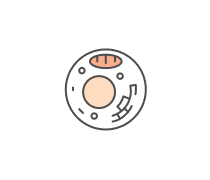Glucose is a source for the production of ATP
Proteins are synthesised in ribosomes
Simple Epithelia has three types : simple squamous, simple cuboidal...
All nerve cells have an axon
Erythrocytes transport oxygen
The release of energy from glucose is done through cell respiration
The ground substance of cartilage has high resilience
Stratified squamous epithelia is found in the epidermis
Elastin fibres are fine-branched and yellow
The size of a red blood cell is 8 micrometers
The digestive tract contains simple cuboidal and columnar epithelia
The Golgi complex can kill bacteria
Skeletal muscle contains very little mithochondria
Plasma is yellow
During telophase, there are two nuclear membranes
Connective tissue has little intercellular material
A synapse can involve a muscle cell with another muscle cell
The main function of the digestive system is to get rid of waste...
The endocrine gland is a ductless gland
Glands are particular because they are only unicellular
Digestive enzymes are contained in lysosomes
Translation is the production of protein from mRNA
Muscle cells are polygonal in cross section
Fibroblasts are cells present in loose connective tissue
Vesicle Transport does not require energy
Bones are living tissue, with many cells but with a low blood suply
Endocrine glands secrete substances onto surfaces
Cardiac muscle cells are uninucleate
The movement of a substance from an area of low concentraion to a high...
Exocytosis involves the Golgi complex
A nerve fibre is not a process of a neuron
An erythrocyte is a true cell
Phagocytosis is a type of exocytosis
If blood was injected with a hypertonic solution of saline, cells...
A third of the dry weight of bone is composed of protein, mostly...
Osmosis occurs when the solvent molecules are too large to pass...
Lysosomes are either free or in small clusters or can attach to the...
Endoplasmic Reticulum serves in packaging material for export outside...
Tendons are made up of regular loose connective tissue
A type of cartilage that can be found in the ear is called Hyalin...
Epithelia is not characterised by little intercellular material
Transcription is the production of protein from mRNA
Muscle tissue is made up of 'excitable cells', this is the...
Fibrocartilage is a type of cartilage found in many joints and in the...
Leucocytes are the only true cells in blood
Mucus works with microvilli to flush particles along the surfaces
During Prohase, the genetic material duplicates
Myofibrils secrete fibers and ground substance
Collagen fibres stretch and are able to return to their original form
Cilia are microscopic cell projections that increase the surface area...
An enzyme is an inorganic substance that accelerates chemical...
In active transport, the solute molecules move from an area of high...
Mitosis produces 2 genetically modified daughter cells
The centrioles migrate to opposite sides in the Anaphase
The process by which the genetic material duplicates twice but divides...
Cell division is the sequence of Interphase, Prophase, Metaphase,...
The integumentary system is a system composed of organs such as the...
Axons conduct electrical activity to the nerve cell body
In osmosis, water moves from an area of higher osmotic pressure to an...
Intercellular material is the material that is within the cells
















